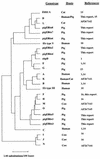Prevalence of Enterocytozoon bieneusi in swine: an 18-month survey at a slaughterhouse in Massachusetts
- PMID: 11976142
- PMCID: PMC127518
- DOI: 10.1128/AEM.68.5.2595-2599.2002
Prevalence of Enterocytozoon bieneusi in swine: an 18-month survey at a slaughterhouse in Massachusetts
Abstract
Slaughterhouse pig samples were analyzed by PCR for Enterocytozoon bieneusi infection. Thirty-two percent were found to be positive, with rates being higher over the summer months. Three isolates from pigs were identical in their ribosomal internal transcribed spacer sequence to human E. bieneusi type D, two were identical to type F (from a pig), and nine were previously unreported. The viability of these spores was demonstrated by their ability to infect gnotobiotic piglets. The presence of the infection in liver was shown by in situ hybridization.
Figures


References
-
- Breitenmoser, A. C., A. Mathis, E. Burgi, R. Weber, and P. Deplazes. 1999. High prevalence of Enterocytozoon bieneusi in swine with four genotypes that differ from those identified in humans. Parasitology 118:447-453. - PubMed
-
- Carville, A., K. Mansfield, G. Widmer, A. Lackner, D. Kotler, P. Wiest, T. Gumbo, S. Sarbah, and S. Tzipori. 1997. Development and application of genetic probes for detection of Enterocytozoon bieneusi in formalin-fixed stools and in intestinal biopsy specimens from infected patients. Clin. Diagn. Lab. Immunol. 4:405-408. - PMC - PubMed
-
- del Aguila, C., F. Izquierdo, R. Navajas, N. J. Pieniazek, G. Miro, A. I. Alonso, A. J. Silva, and S. Fenoy. 1999. Enterocytozoon bieneusi in animals: rabbits and dogs as new hosts. J. Eukaryot. Microbiol. 46:8S-9S. - PubMed
-
- Deplazes, P., A. Mathis, C. Muller, and R. Weber. 1996. Molecular epidemiology of Encephalitozoon cuniculi and first detection of Enterocytozoon bieneusi in faecal samples of pigs. J. Eukaryot. Microbiol. 43:93S. - PubMed
Publication types
MeSH terms
Substances
Grants and funding
LinkOut - more resources
Full Text Sources

